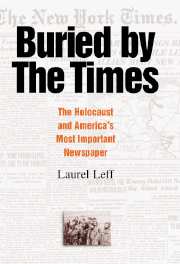Book contents
- Frontmatter
- Dedication
- Contents
- Acknowledgments
- Note Abbreviations
- Introduction: “Last Voice from the Abyss”
- PART I 1933—1941
- PART II 1942—1945
- 5 “To Awaken the Conscience of Christendom”: Pressure to Publicize the First News of the Extermination Campaign
- 6 “Amidst the Advertisements on Page 19”: Placement Decisions and the Role of the News Editors
- 7 “All Jews Are Not Brothers”: The Publisher's Fight with Zionists
- 8 “The Semitic Question Should Be Avoided”: German Atrocities and U.S. Government Propaganda
- 9 “Final Phase of Supreme Tragedy Has Begun”: The War Refugee Board and the Destruction of Hungary's Jews
- 10 “Political Prisoners, Slave Laborers, and Civilians of Many Nationalities”: The Liberation of the Concentration Camps
- 11 “Lessons from the Hitler Tragedy”: The Publisher and the Aftermath of War
- Conclusion: “The Horrible Story Was Not Told”
- Appendix A Key Individuals
- Appendix B Key Institutions
- Appendix C List of Front-Page Stories
- Notes
- Index
6 - “Amidst the Advertisements on Page 19”: Placement Decisions and the Role of the News Editors
Published online by Cambridge University Press: 05 February 2015
- Frontmatter
- Dedication
- Contents
- Acknowledgments
- Note Abbreviations
- Introduction: “Last Voice from the Abyss”
- PART I 1933—1941
- PART II 1942—1945
- 5 “To Awaken the Conscience of Christendom”: Pressure to Publicize the First News of the Extermination Campaign
- 6 “Amidst the Advertisements on Page 19”: Placement Decisions and the Role of the News Editors
- 7 “All Jews Are Not Brothers”: The Publisher's Fight with Zionists
- 8 “The Semitic Question Should Be Avoided”: German Atrocities and U.S. Government Propaganda
- 9 “Final Phase of Supreme Tragedy Has Begun”: The War Refugee Board and the Destruction of Hungary's Jews
- 10 “Political Prisoners, Slave Laborers, and Civilians of Many Nationalities”: The Liberation of the Concentration Camps
- 11 “Lessons from the Hitler Tragedy”: The Publisher and the Aftermath of War
- Conclusion: “The Horrible Story Was Not Told”
- Appendix A Key Individuals
- Appendix B Key Institutions
- Appendix C List of Front-Page Stories
- Notes
- Index
Summary
Throughout 1943, the New York Times continued to run stories about the extermination of the Jews inside the paper. Stories about the end of individual ghettos appeared on pages 10 and 5. Stories about the end of entire Jewish communities appeared on pages 2 and 6. Stories that tallied the mounting death toll appeared on pages 9 and 7. Stories that told of the extension of the murderous campaign to Italy and Bulgaria appeared on pages 8, 35, 4, and 6. A story on the precise methods used at the Treblinka extermination camp appeared on page 11. Stories that contained eyewitness testimony from the just-liberated areas of the Soviet Union appeared on pages 3, 10, and 19. Even the stirring accounts of the Warsaw ghetto uprising and the rescue of Danish Jews were told almost exclusively inside the newspaper. The breakthrough that World Jewish Congress leaders assumed had occurred when the United Nations confirmed Germany's extermination campaign had not happened. The plight of the Jews still was not considered important enough for the front page.
Although one man, the assistant night managing editor, essentially made the day-to-day decisions that kept the extermination campaign off the New York Times' front page, his actions were the product of the newspaper's tangled corporate culture.
- Type
- Chapter
- Information
- Buried by the TimesThe Holocaust and America's Most Important Newspaper, pp. 164 - 191Publisher: Cambridge University PressPrint publication year: 2005



